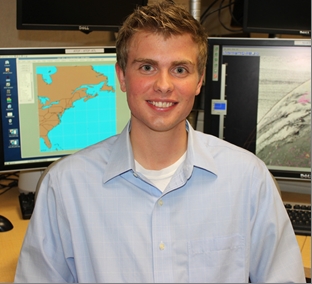Q & A with NHC - David Zelinsky
 David Zelinsky
David Zelinsky
Hurricane Model Diagnostician and Meteorologist
National Hurricane Center
By Dennis Feltgen
Public Affairs Officer
NOAA Communications & External Affairs
National Hurricane Center
Let's begin with that job title. What is a "hurricane model diagnostician"?
My job is part of the Hurricane Forecast Improvement Project (HFIP). My primary responsibility is to take a look at the models that the Environmental Modeling Center (EMC) runs, especially the GFDL and HWRF. I dig into the models and try to find both errors and things that they are doing well. I then report that information back to the hurricane specialists and the modelers at EMC. I also work on developing model output graphics for the specialists that allow them to quickly examine the structure of a forecasted storm.
Is this something you always wanted to do?
Not exactly. Ever since I wanted to become a meteorologist, I knew I wanted to do hurricane work. But I had no clue as to what specifically that would be.
What planted the weather bug into you?
When I was four, there was a huge cottonwood tree that fell onto my house outside of Detroit during a storm. That was the defining moment for me. When I was in elementary school, I would come home and turn on The Weather Channel rather than cartoons.
Obviously, you were a meteorology major in college.
I was, and went to Purdue University in Indiana. A "Boilermaker" for life! I was in the marching band there, too. During my senior year, I spent a lot of time trying to figure out what I wanted to do at that point. Should I try to get a job, or go on for an advanced degree?
And the decision was?
I always wanted to do hurricanes, but Purdue does not have a big tropical meteorology program. I ended up going to Florida State, with the opportunity to work with Dr. T.N. Krishnamurti, one of the most renowned tropical meteorology specialists in the country. There was no way I was going to turn down the opportunity. I worked with "Krish", using some diagnostic parameters to create a statistical intensity forecasting model based on the HWRF model. I also had the opportunity to work as a student forecaster on the NASA Genesis and Rapid Intensification Processes field campaign. A combination of those two things led me to the contract position that opened up here at NHC just as I was graduating from Florida State with my Masters.
Do you like it?
I could not ask for a better place to be. I love the work because I am in a really unique spot. Most meteorologists are either set in operations or research. I have a job where I get to work equally with both. I will work an HSM (Hurricane Support Meteorologist) shift with the specialists here, and we'll discuss something going on with the models. And then I can immediately take that, maybe the very next day, and talk to the people at EMC about those concerns and have a chance to work with the model development and all of the research that goes with it. Then I can come back the next day right into operations.
That is an impressive and quick turnaround for field testing.
Normally it takes about a year to get these things in the models. But during the past year, something that one of the hurricane specialists noticed early in the season led to immediate improvements in the HWRF model, with a fix in August that helped it produce better forecasts.
A big goal of HFIP is to reduce both track and intensity forecast errors by 50 percent.
It is attainable. We are already seeing improvements in the track forecasts. And a lot of the experimental models are starting to show some real promise in terms of intensity forecasting.
What is it that we need to find in order to reduce the intensity forecast errors?
Intensity is tricky because it's one of the processes that we don't yet fully understand. It is difficult to ask a model to predict something when we don't even understand what it going on. We can't program the model correctly. But as we are getting better observations and higher-resolution models, we are very slowly seeing that improvement.
What do you do in real life?
I play ice hockey! I am in a men's league down here. There is only one rink in all of Miami-Dade County, but it does not have a league. So I go up to Broward (County) to play, and it's worth it. It's kind of weird though; I've spent time in Indiana and upstate New York, yet this is the first place I've lived since high school where there was a rink close enough for me to play.
Where do you see yourself in 10 years?
I don't really know. I love what I am doing now, but HFIP is not going to last forever. Hopefully, hurricane forecasts will improve so much that they won't need another HFIP. I hope I can stay here for as long as possible, but I have an open mind for the future.
Do you see it being more in operations, research, or a combination?
I would love to stay in a combination, but I know most people are oriented one way or the other. I have to see what opportunities are there when it comes time for me to decide.
Send comments to: NHC.Public.Affairs@noaa.gov
Return to Q & A index of stories


